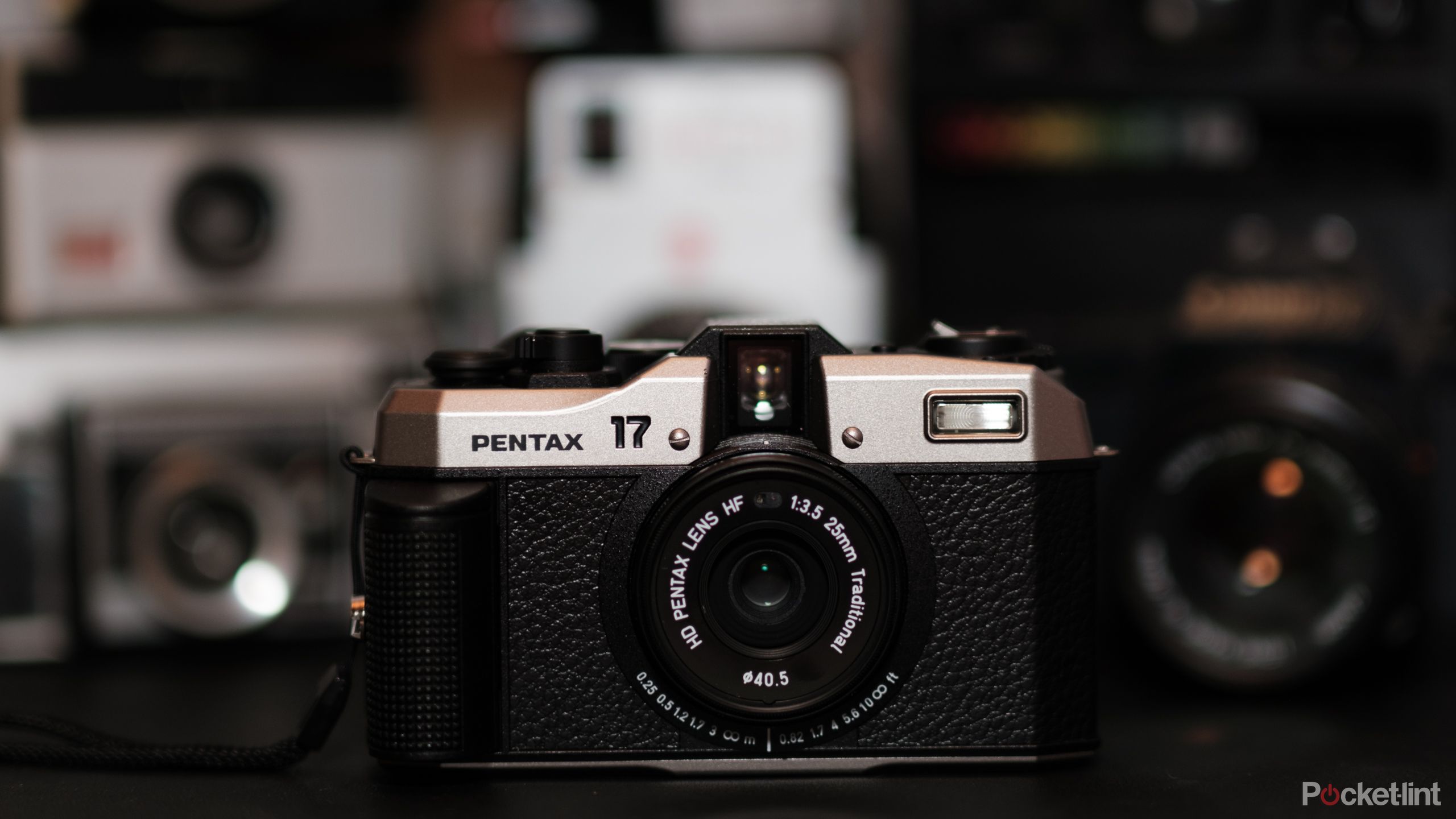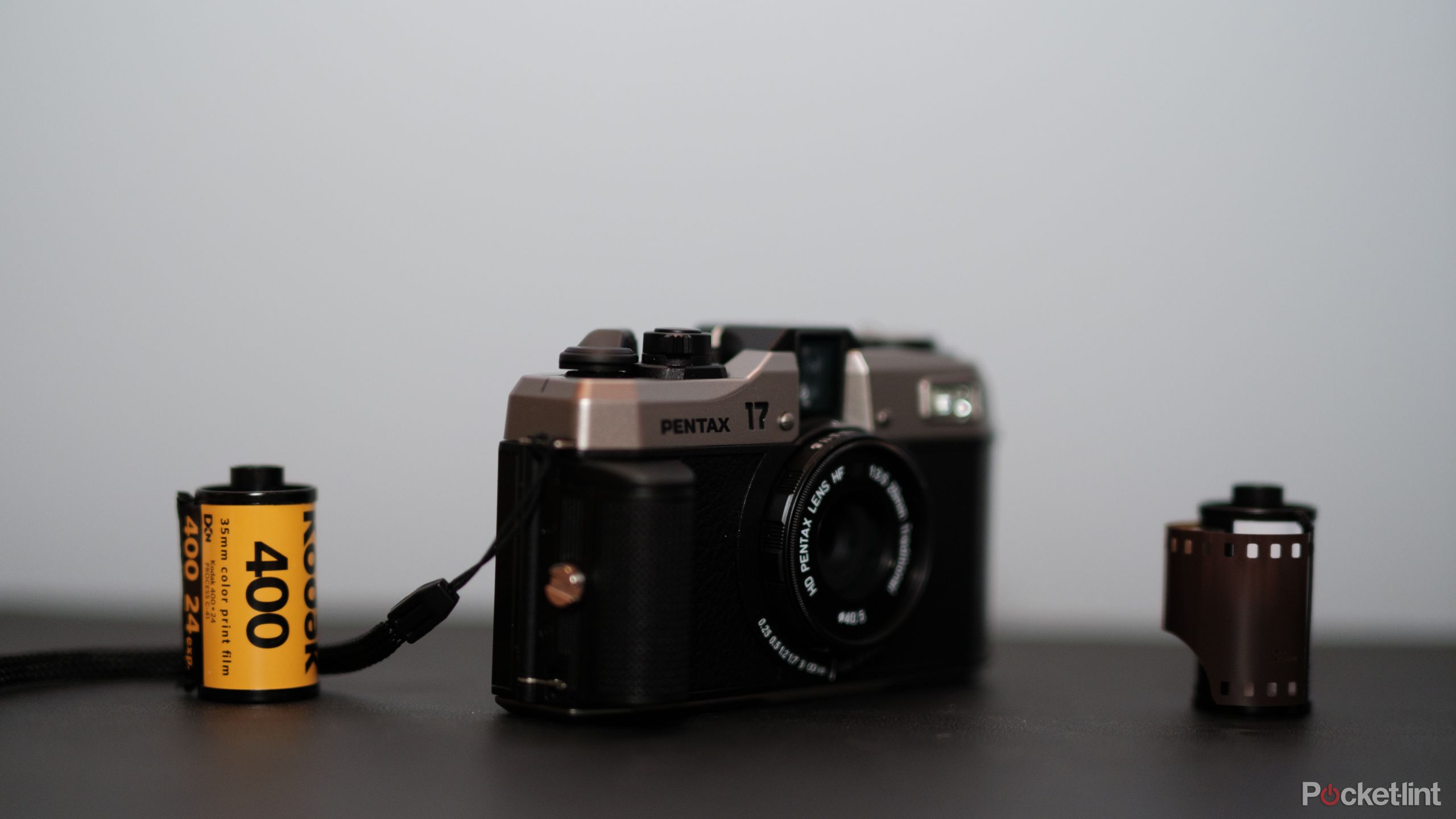Despite predictions of digital technology spelling doom for analog cameras, film photography has never fully fizzled out. But as the younger generation buys old school digital point-and-shoots to stay in the moment and off their smartphone (even with their high-quality cameras), film could very well be the next step in an increasing craving for authenticity and retro technology. The Pentax 17 is the brand’s first new film camera in over 20 years , a conglomeration of vintage and modern designed to pique the interest of new film photographers.
While the Pentax 17 uses manual film advancement and zone focusing, the compact film camera blends vintage-inspired features with those designed to ease modern photographers into the old art form. The 17 uses 35mm film but is a half-frame camera, which means each roll of film takes twice as many photos as advertised. Such a design also means the Pentax 17 shoots vertically by default — rather than the more standard horizontal — and in a 17mm by 24mm size that’s closer to the space on a smartphone screen. The camera lacks full manual controls but offers essential controls like an aperture priority mode, exposure compensation, and the ability to turn the built-in flash on and off.
I’ve had an old Pentax K1000 on my shelf for years now, an old garage sale find that I’ve never really found the time to dabble with. The Pentax 17 has proved to be just the camera I needed to ease into the waters of film photography before diving headfirst into fully manual film cameras.
Recommended
Pentax 17
The Pentax 17 is an easier entry into film photography. The camera’s mix of automated modes and half-frame format will appeal to photographers who have never tried film. Serious film photographers may find the Pentax 17 lacking, however, as it doesn’t offer manual modes, double exposure, or interchangeable lenses. But, for easing into film, the Pentax 17 has a lot to offer.
- Easy to learn
- Compact, retro design
- Beautiful real film images
- Errors rewinding film
- No manual exposure
- Battery isn’t rechargeable
Price, specs and availability
The Pentax 17 was announced in June 2024 and retails for about $500. The Pentax 17 is a compact film camera with a fixed 25mm lens. While it accepts 35mm film, it’s a half-frame format, which means that a roll of 36-exposure film actually takes 72 images because each exposure can take two photographs. Its most notable specs include a zone-focusing system, which is a simpler form of manual focusing, and a non-rechargeable CR2 battery.
What I like about the Pentax 17
The camera is an easy introduction to film photography
If a digital and a film camera played Chicken and collided, I imagine the result would look something like the Pentax 17. The camera is a mishmash of vintage and modern, but that’s not necessarily a bad thing. Like a film camera, the top houses a manual rewind crank, a film advance knob and a clicky shutter release. But, the mode dial has an auto mode as well as an assortment of other options, including a “bokeh” mode for wider apertures and bulb for long exposures.
The Pentax 17 is also a great blend between comfortable and portable. The battery compartment doubles as a bump grip to wrap your fingers around it fairly comfortably. But, at 10.2 ounces, it’s not hard to tuck into a bag and pull out when a photographic opportunity presents itself.
The convergence of modern and classic helps make the Pentax 17 a beginner-friendly film camera. Two indicator lights right at the viewfinder help warn you if you forgot to advance the film or the image is too dark because you forgot to remove the lens cap (guilty as charged). Granted, this is the first time that I’ve felt the need to carry around an instruction manual in my camera bag for that moment when I needed to remember how to rewind and reload the film, but the shooting settings themselves felt natural and intuitive.
Part of the 17’s modern feel is the fact that it shoots half-frame images, or two images on every single standard exposure of 35mm film. Even the viewfinder is vertical, rather than horizontal, and you turn the camera to shoot a horizontal image instead of the other way around.
The result is a vertical image that’s slightly wider than a 2:3 aspect ratio that feels destined to fill a smartphone screen. Is a film camera in a format designed for smartphone screens sacrilege? Perhaps, but this is the world that we live in. This also allows you to get twice as many images per roll of film, which is more bang for your buck on film costs but can up the cost of developing that film.
The imperfections didn’t always feel like a bad thing.
While the built-in lens plays a role, on a film camera, much of the image quality instead stems from whatever film that you load inside. I tested the Pentax 17 with Kodak UltraMax color and Ilford black and white, both ISO 400 films. The resulting images have that beautiful, authentic film feel that digital filters try (and often fail) to imitate. The color film delivered the deep yet less saturated greens and reds that remind me of my childhood photos. The black and white film delivered deep contrast in a rich monochrome image. Both had lovely film grain that simply doesn’t compare with the noise of digital sensors.
The film images feel less perfect, yet more emotive than if I had taken the same shots with a digital camera. Are some out of focus from the sort of guesswork that comes with judging how far away the subject is? Yes, but the imperfections didn’t always feel like a bad thing.
What I didn’t like about the Pentax 17
Rewind instructions weren’t clear and some advanced features are missing
While the Pentax 17 felt like a simpler transition from digital to film, the experience didn’t go without its challenges. The film did not fully rewind in both rolls that I shot. This could have been user error due to bad instructions — as “turn until you feel resistance, then turn three more times” feels open to interpretation. Just how much resistance? What happens if I turn more than three times?
On both rolls, when I popped the back open, the film hadn’t completely rewound. I had to shoot the door again and rewind much more than the three times that the instruction manual says before the film fully wound, but by then the damage to the roll was already done. Either clearer instructions or some sort of indicator of whether the film was fully rewound would have made a world of difference — or, perhaps, changing the roll out in a dark room, just in case.
While the premature opening of the camera back — not knowing the film hadn’t fully rewound — ruined a few frames, it created light leaks in others. Yes, some of the light leak images were complete trash, but it’s worth noting that some were happy accidents, where the bit of glow on the edge of the frame added to the feel of the image, rather than detracting from it.
Another aspect that I didn’t love was the focus dial around the lens. The design uses small icons to indicate the general subject distance, like mountains for far away and silverware for a tabletop shot. It’s a focusing type that photographers call zone focusing. While the focus setting appears in the viewfinder as a reminder, I forgot several times, and even when I didn’t, a lot of it is guesswork as to how close the subject is.
I missed the tactile feel of turning the manual focus lens and watching the image come into focus in the viewfinder, something the old 35mm cameras on my shelf offer. With the Pentax 17, you can’t tell using the viewfinder whether or not the image is in focus.
I think a rechargeable battery would go one step further into making the 17 the best of both old and new, but, alas, the battery is the throwaway type.
As easy as the Pentax 17 was to jump into, I also feel like serious photographers may grow out of the $500 camera a little quickly. The Pentax 17 feels like a gateway drug to harder, serious photography. The 17 lacks full manual exposure control, the lens is fixed and not interchangeable, and the camera also wouldn’t let me attempt a double exposure. I loved the images coming from the Pentax 17, but the introductory experience to 35mm film also left me wanting to dive into old SLRs too.
Should you buy the Pentax 17?
It could be the gateway to film photography, but with a short runway
The Pentax 17 eases budding photographers into the world of film photography. With all new parts and a complete instruction manual, the 17 is an easier jump than a used film camera. After shooting with the 17, I was actually able to figure out why the film wasn’t loading on the old Pentax K1000 SLR I picked up at a garage sale years ago. My experience with the 17 helped build some much-needed film troubleshooting skills.
While the dials and controls on the Pentax 17 mix the modern and vintage for simpler operation, the resulting images have that beautiful, emotive feel of film. The images aren’t perfect, but, honestly, that’s sort of the point. Getting back a grainy, contrast-filled but imperfect image feels like a more honest representation of the moment.
It’s fairly easy to find a vintage 35mm SLR with interchangeable lenses for less.
If you’ve always wanted to try film photography, but beginner’s nerves have always gotten in the way, buy the Pentax 17. The camera is an easier entry into 35mm film — however, as you’re factoring in the cost of the camera, the cost of film, and the cost of film development, you may just get hooked on film and want to grow into a camera with interchangeable lenses and full manual controls.
If you want to dive right into film with full manual controls, then the Pentax 17 isn’t the right choice. You can also find more focal length options and better background blur by choosing a camera that isn’t half-frame and can swap lenses. Another mark in the “don’t buy column” is the cost. $500 is great compared to today’s digital cameras, but it’s fairly easy to find a vintage 35mm SLR with interchangeable lenses for less than that.
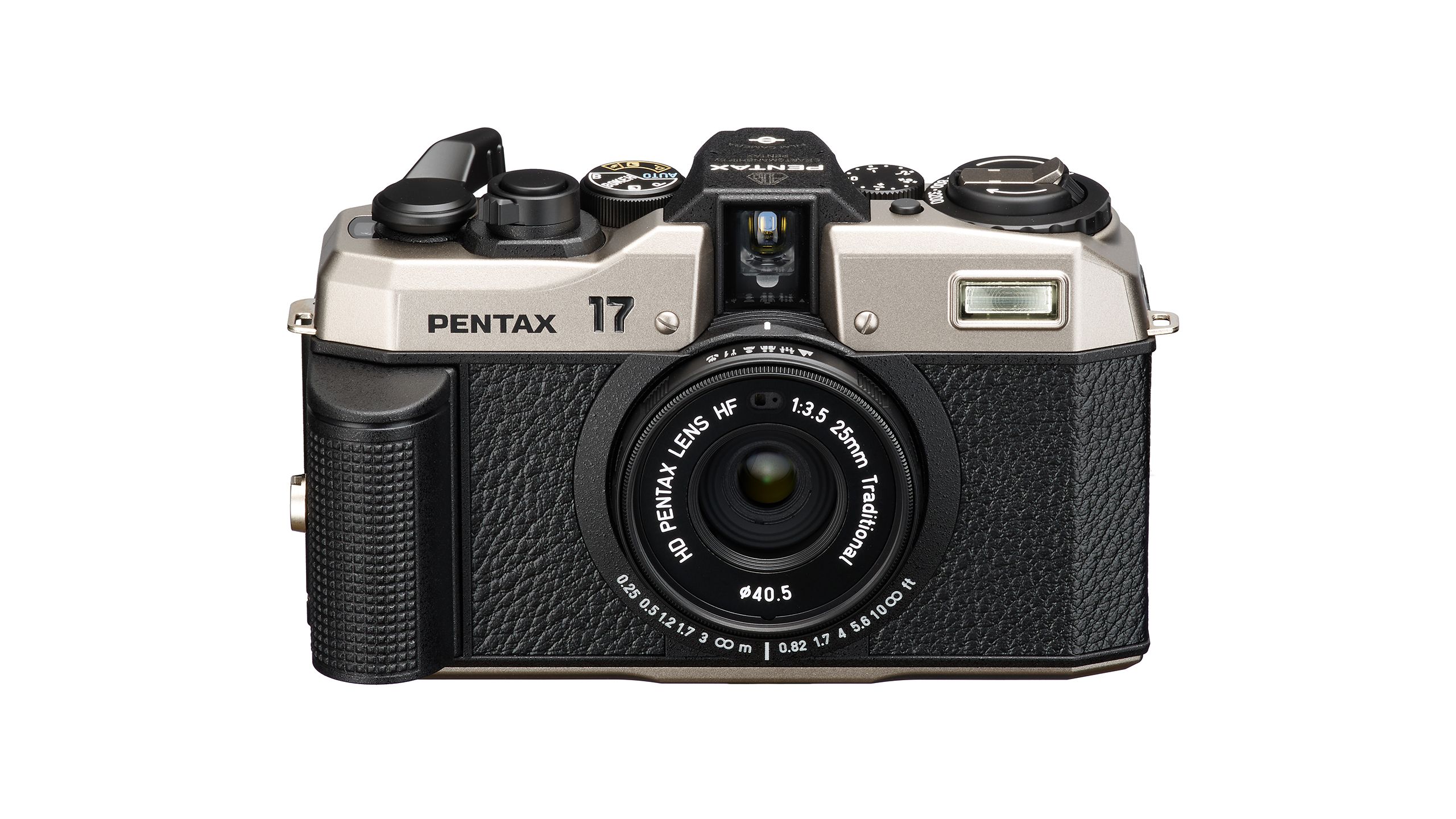

Recommended
Pentax 17
Trending Products

Cooler Master MasterBox Q300L Micro-ATX Tower with Magnetic Design Dust Filter, Transparent Acrylic Side Panel…

ASUS TUF Gaming GT301 ZAKU II Edition ATX mid-Tower Compact case with Tempered Glass Side Panel, Honeycomb Front Panel…

ASUS TUF Gaming GT501 Mid-Tower Computer Case for up to EATX Motherboards with USB 3.0 Front Panel Cases GT501/GRY/WITH…

be quiet! Pure Base 500DX Black, Mid Tower ATX case, ARGB, 3 pre-installed Pure Wings 2, BGW37, tempered glass window

ASUS ROG Strix Helios GX601 White Edition RGB Mid-Tower Computer Case for ATX/EATX Motherboards with tempered glass…


